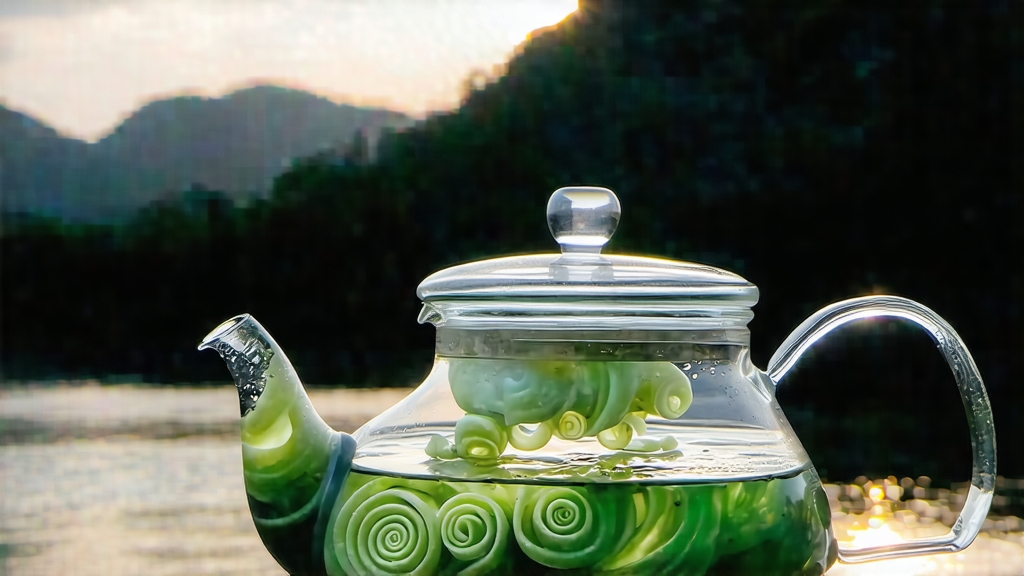
Biluochun, whose name translates literally to “Green Snail Spring,” is one of China’s ten most celebrated teas, yet it remains curiously under-celebrated outside the circles of serious tea aficionados. Produced only in a micro-zone where the eastern edge of Jiangsu Province meets the vast, mist-fed basin of Lake Tai, this tea is prized for its improbably tiny spiral-shaped leaves, an aroma that recalls fresh apricots and white flowers, and a cup that tastes like liquid morning light. To understand Biluochun is to understand how Chinese green tea can compress an entire season into a single sip.
History: From Poison Antidote to Imperial Tribute
Local chronicles first mention the tea under the Song dynasty (960-1279), but its mythic origin is set in the Ming. A nun in the Dongting mountains is said to have picked a few wild leaves after noticing that venomous snakes avoided a particular shrub. She brewed the leaves, found the infusion both fragrant and detoxifying, and shared the discovery with villagers. By the late 1600s the Kangxi Emperor, touring the lower Yangtze, tasted the tea while it was still nameless. Struck by its “green color, spiral form, and early spring vitality,” he christened it Biluochun—bi for green, luo for snail, chun for spring. The name stuck, and the tea entered the imperial tribute list, transported northward each year in bamboo-lined chests packed with orange peel to preserve moisture and perfume.
Terroir: Lake Tai’s Mist and Fruit Trees
Authentic Biluochun comes from only two peninsulas jutting into Lake Tai: Dongting Dongshan and Dongting Xishan. The lake’s warm daytime vapors meet cool night air, generating a nearly perpetual mist that filters sunlight into soft, diffused rays. The bushes grow interplanted with peach, plum, and apricot trees; their roots share the same acidic, sandy loam, and their blossoms shower pollen onto tea leaves, adding a subtle floral note that chemists trace to increased concentrations of linalool and geraniol. Yields are minuscule—one mu (1/15 hectare) produces barely eight kilograms of finished tea—making every leaf a botanical jewel.
Varietals: Seven Saplings of a Single Mountain
Although all Biluochun is made from the Camellia sinensis var. sinensis species, clonal selection over centuries has produced seven recognized “pin zhong” or garden cultivars. The most prized is “Xiao Ye” (Small Leaf), whose leaves are barely 1.5 cm long and curl naturally into the tightest spirals. “Zao Bei” (Early North) ripens a week ahead of others, risking spring frost but rewarding farmers with the season’s first premium price. “Wu Niu Zao” (Black Bull Early) yields a slightly darker liquor and is favored for export because its fragrance survives long sea transit. Each cultivar is tracked by QR-coded bamboo tags during plucking so that batches can be traced back to a single row of bushes.
Plucking: One Bud, One Leaf, Before the Rain
The harvest window opens around Grain Rain (April 20) but peaks two weeks earlier when night temperatures hover at 10 °C and morning mist lingers until 9 a.m. Pickers—usually women wearing bamboo hats and indigo jackets—work in pairs, singing short, antiphonal songs to keep rhythm. The standard is “one bud, one leaf, 1.5 centimeters,” about the length of a dragonfly’s wing. A seasoned picker gathers only 600 grams of fresh leaves in four hours; it takes 55,000 of these shoots to yield one kilogram of dry tea.
Craft: The Five Motions of a Master
Within minutes of plucking, leaves are spread on bamboo trays and cooled in open-walled pavilions to evaporate surface moisture. The craft proceeds through five motions that must finish before dawn:
- Kill-Green (sha qing): A 200 °C drum pan fires the leaves for 90 seconds, arresting oxidation and locking in chlorophyll.
- Roll-Spiral (rou nian): While still hot, leaves are hand-rubbed against the mesh bottom of a wicker basket, coiling them into tight spirals and rupturing cell walls to release aromatic oils.
- First Dry (hong pei): Temperature drops to 70 °C; leaves are tumbled for eight minutes until moisture falls to 30 %.
- Second Spiral: Masters